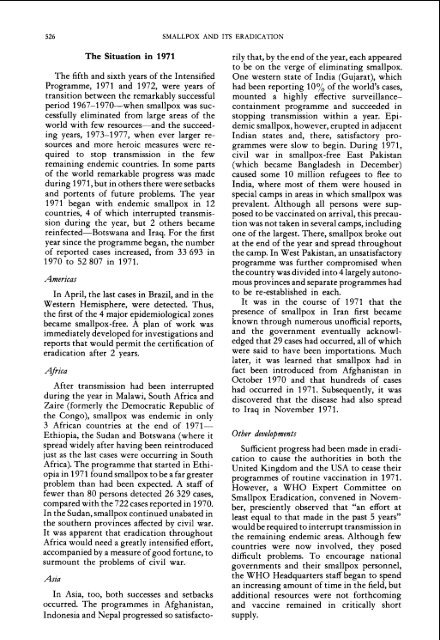smallpox eradication - libdoc.who.int - World Health Organization
smallpox eradication - libdoc.who.int - World Health Organization
smallpox eradication - libdoc.who.int - World Health Organization
You also want an ePaper? Increase the reach of your titles
YUMPU automatically turns print PDFs into web optimized ePapers that Google loves.
526 SMALLPOX AND ITS ERADICATION<br />
The Situation in 1971<br />
The fifth and sixth years of the Intensified<br />
Programme, 1971 and 1972, were years of<br />
transition between the remarkably successful<br />
period 1967-1 970-when <strong>smallpox</strong> was successfully<br />
eliminated from large areas of the<br />
world with few resources-and the succeeding<br />
years, 1973-1977, when ever larger resources<br />
and more heroic measures were required<br />
to stop transmission in the few<br />
remaining endemic countries. In some parts<br />
of the world remarkable progress was made<br />
during 1971, but in others there were setbacks<br />
and portents of future problems. The year<br />
1971 began with endemic <strong>smallpox</strong> in 12<br />
countries, 4 of which <strong>int</strong>errupted transmission<br />
during the year, but 2 others became<br />
reinfected-Botswana and Iraq. For the first<br />
year since the programme began, the number<br />
of reported cases increased, from 33 693 in<br />
1970 to 52 807 in 1971.<br />
Americas<br />
In April, the last cases in Brazil, and in the<br />
Western Hemisphere, were detected. Thus,<br />
the first of the 4 major epidemiological zones<br />
became <strong>smallpox</strong>-free. A plan of work was<br />
immediately developed for investigations and<br />
reports that would permit the certification of<br />
<strong>eradication</strong> after 2 years.<br />
Africa<br />
After transmission had been <strong>int</strong>errupted<br />
during the year in Malawi, South Africa and<br />
Zaire (formerly the Democratic Republic of<br />
the Congo), <strong>smallpox</strong> was endemic in only<br />
3 African countries at the end of 1971-<br />
Ethiopia, the Sudan and Botswana (where it<br />
spread widely after having been re<strong>int</strong>roduced<br />
just as the last cases were occurring in South<br />
Africa). The programme that started in Ethiopia<br />
in 1971 found <strong>smallpox</strong> to be a far greater<br />
problem than had been expected. A staff of<br />
fewer than 80 persons detected 26 329 cases,<br />
compared with the 722 cases reported in 1970.<br />
In the Sudan, <strong>smallpox</strong> continued unabated in<br />
the southern provinces affected by civil war.<br />
It was apparent that <strong>eradication</strong> throughout<br />
Africa would need a greatly <strong>int</strong>ensified effort,<br />
accompanied by a measure of good fortune, to<br />
surmount the problems of civil war.<br />
Asia<br />
In Asia, too, both successes and setbacks<br />
occurred. The programmes in Afghanistan,<br />
Indonesia and Nepal progressed so satisfacto-<br />
rily that, by the end of the year, each appeared<br />
to be on the verge of eliminating <strong>smallpox</strong>.<br />
One western state of India (Gujarat), which<br />
had been reporting 10% of the world's cases,<br />
mounted a highly effective surveillancecontainment<br />
programme and succeeded in<br />
stopping transmission within a year. Epidemic<br />
<strong>smallpox</strong>, however, erupted in adjacent<br />
Indian states and, there, satisfactory programmes<br />
were slow to begin. During 1971,<br />
civil war in <strong>smallpox</strong>-free East Pakistan<br />
(which became Bangladesh in December)<br />
caused some 10 million refugees to flee to<br />
India, where most of them were housed in<br />
special camps in areas in which <strong>smallpox</strong> was<br />
prevalent. Although all persons were supposed<br />
to be vaccinated on arrival, this precaution<br />
was not taken in several camps, including<br />
one of the largest. There, <strong>smallpox</strong> broke out<br />
at the end of the year and spread throughout<br />
the camp. In West Pakistan, an unsatisfactory<br />
programme was further compromised when<br />
the country was divided <strong>int</strong>o 4 largely autonomous<br />
provinces and separate programmes had<br />
to be re-established in each.<br />
It was in the course of 1971 that the<br />
presence of <strong>smallpox</strong> in Iran first became<br />
known through numerous unofficial reports,<br />
and the government eventually acknowledged<br />
that 29 cases had occurred, all of which<br />
were said to have been im~ortations. Much<br />
later, it was learned that <strong>smallpox</strong> had in<br />
fact been <strong>int</strong>roduced from Afghanistan in<br />
October 1970 and that hundreds of cases<br />
had occurred in 1971. Subsequently, it was<br />
discovered that the disease had also spread<br />
to Iraq in November 1971.<br />
Other developments<br />
Sufficient progress had been made in <strong>eradication</strong><br />
to cause the authorities in both the<br />
United Kingdom and the USA to cease their<br />
programmes of routine vaccination in 1971.<br />
However, a WHO Expert Committee on<br />
Smallpox Eradication, convened in November,<br />
presciently observed that "an effort at<br />
least equal to that made in the past 5 years"<br />
would be required to <strong>int</strong>errupt transmission in<br />
the remaining endemic areas. Although few<br />
countries were now involved, they posed<br />
difficult problems. To encourage national<br />
governments and their <strong>smallpox</strong> personnel,<br />
the WHO Headquarters staff began to spend<br />
an increasing amount of time in the field, but<br />
additional resources were not forthcoming<br />
and vaccine remained in critically short<br />
supply.
















